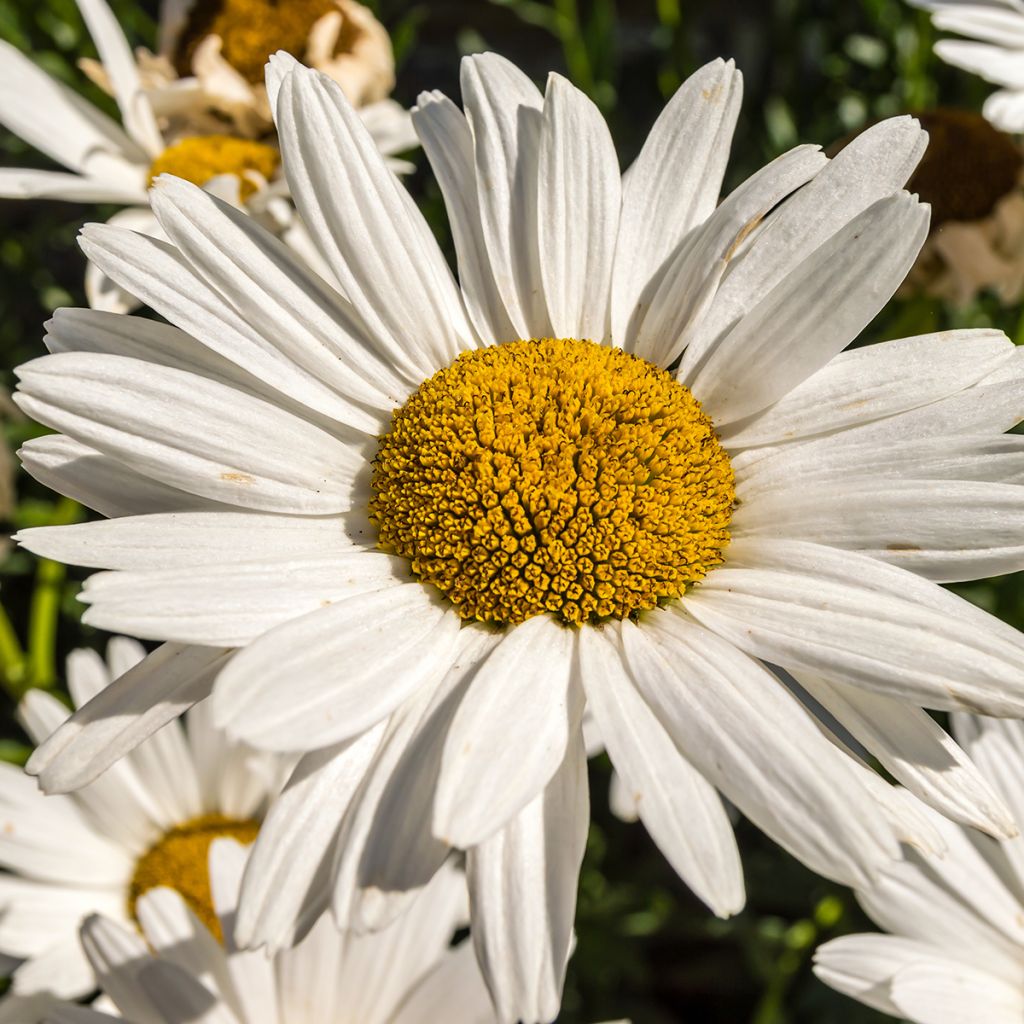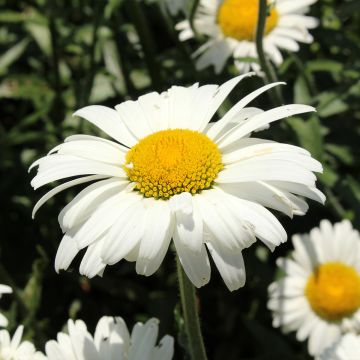

Leucanthemum x superbum Brightside - Grande marguerite


Leucanthemum x superbum Brightside - Grande marguerite


Leucanthemum x superbum Brightside - Grande marguerite


Leucanthemum x superbum Brightside - Grande marguerite
Leucanthemum superbum Brightside - Shasta Daisy
Leucanthemum x superbum Brightside
Shasta Daisy
Special offer!
Receive a €20 voucher for any order over €90 (excluding delivery costs, credit notes, and plastic-free options)!
1- Add your favorite plants to your cart.
2- Once you have reached €90, confirm your order (you can even choose the delivery date!).
3- As soon as your order is shipped, you will receive an email containing your voucher code, valid for 3 months (90 days).
Your voucher is unique and can only be used once, for any order with a minimum value of €20, excluding delivery costs.
Can be combined with other current offers, non-divisible and non-refundable.
Home or relay delivery (depending on size and destination)
Schedule delivery date,
and select date in basket
This plant carries a 12 months recovery warranty
More information
We guarantee the quality of our plants for a full growing cycle, and will replace at our expense any plant that fails to recover under normal climatic and planting conditions.
Would this plant suit my garden?
Set up your Plantfit profile →
Description
Leucanthemum x superbum 'Brightside' is a large daisy in the same vein as 'Becky', but bushier and with even stronger stems. Very branched, bearing large white flowers with bright yellow centres, the plant resembles a very large bouquet in summer. It is an excellent garden perennial, a versatile and trouble-free plant that will not disappoint, even for novice gardeners. Well suited to slightly moist, clay and heavy soil, it is one of those summer queens, with a charming and childlike appeal, essential in a flower garden as well as in wildflower bouquets.
The genus Leucanthemum belongs to the Asteraceae family. 'Brightside' is one of the many hybrids of Leucanthemum x superbum, the well-known Shasta Daisy. It is a variety that is particularly hardy, to-20°C (-4°F), strong, floriferous, vigorous, robust, and disease-resistant. It grows rapidly, forming a dense, more tall than wide, ball-shaped clump in a few years. It measures about 80 cm (32in) in height and its stump occupies 40 cm (16in). Lush in summer, it completely disappears in winter. Flowering occurs from June to September, in the form of large solitary heads measuring 7 to 8 cm (3in) in diameter, composed of white ligules surrounding a large centre of tubular florets in chrome yellow. The floral stems are numerous and particularly strong: they do not require staking and are perfect for cutting. The leaves are matt dark green, simple and alternate with a regularly dentate edge. The plant reaches full maturity in five years. The above-ground vegetation is deciduous and dries up in autumn and regrows in spring.
This lovely summer daisy Brightside, ideal for making bouquets, will be perfect in a border or wildflower meadow, beneath fruit trees or at the edges of the garden. Pair its somewhat simple flowers with that of poppies, blue thistles, phlox, and delphiniums. Combine it with grasses, asters, peonies, blue lupins, or bellflowers. The rustic appearance and intrepid nature of this robust variety remind us of our grandmothers' unpretentious, yet abundantly blooming garden, adding the pleasure of a prolonged summer flowering. Daisies beautifully complement old roses and lilies in bouquets.
Leucanthemum superbum Brightside - Shasta Daisy in pictures


Flowering
Foliage
Plant habit
Botanical data
Leucanthemum
x superbum
Brightside
Asteraceae
Shasta Daisy
Cultivar or hybrid
Other Leucanthemum - Marguerite
View all →Planting and care
Plant Leucanthemum x superbum 'Brightside' in deep, loose, moist but not too dry soil, even clay soil which is well-prepared. This plant tolerates limestone perfectly. It thrives in a sunny, at most partially shaded, position and withstands temperatures as low as -20°C (-4°F). Regularly remove faded flowers and clear the plant in spring to remove dead foliage. This daisy can be attacked by aphids, snails, and may develop some foliar spots if the growing conditions are not optimal. Daisies can be propagated by division in autumn or early spring.
Planting period
Intended location
Care
Planting & care advice
This item has not been reviewed yet - be the first to leave a review about it.
Similar products
Haven't found what you were looking for?
Hardiness is the lowest winter temperature a plant can endure without suffering serious damage or even dying. However, hardiness is affected by location (a sheltered area, such as a patio), protection (winter cover) and soil type (hardiness is improved by well-drained soil).

Photo Sharing Terms & Conditions
In order to encourage gardeners to interact and share their experiences, Promesse de fleurs offers various media enabling content to be uploaded onto its Site - in particular via the ‘Photo sharing’ module.
The User agrees to refrain from:
- Posting any content that is illegal, prejudicial, insulting, racist, inciteful to hatred, revisionist, contrary to public decency, that infringes on privacy or on the privacy rights of third parties, in particular the publicity rights of persons and goods, intellectual property rights, or the right to privacy.
- Submitting content on behalf of a third party;
- Impersonate the identity of a third party and/or publish any personal information about a third party;
In general, the User undertakes to refrain from any unethical behaviour.
All Content (in particular text, comments, files, images, photos, videos, creative works, etc.), which may be subject to property or intellectual property rights, image or other private rights, shall remain the property of the User, subject to the limited rights granted by the terms of the licence granted by Promesse de fleurs as stated below. Users are at liberty to publish or not to publish such Content on the Site, notably via the ‘Photo Sharing’ facility, and accept that this Content shall be made public and freely accessible, notably on the Internet.
Users further acknowledge, undertake to have ,and guarantee that they hold all necessary rights and permissions to publish such material on the Site, in particular with regard to the legislation in force pertaining to any privacy, property, intellectual property, image, or contractual rights, or rights of any other nature. By publishing such Content on the Site, Users acknowledge accepting full liability as publishers of the Content within the meaning of the law, and grant Promesse de fleurs, free of charge, an inclusive, worldwide licence for the said Content for the entire duration of its publication, including all reproduction, representation, up/downloading, displaying, performing, transmission, and storage rights.
Users also grant permission for their name to be linked to the Content and accept that this link may not always be made available.
By engaging in posting material, Users consent to their Content becoming automatically accessible on the Internet, in particular on other sites and/or blogs and/or web pages of the Promesse de fleurs site, including in particular social pages and the Promesse de fleurs catalogue.
Users may secure the removal of entrusted content free of charge by issuing a simple request via our contact form.
The flowering period indicated on our website applies to countries and regions located in USDA zone 8 (France, the United Kingdom, Ireland, the Netherlands, etc.)
It will vary according to where you live:
- In zones 9 to 10 (Italy, Spain, Greece, etc.), flowering will occur about 2 to 4 weeks earlier.
- In zones 6 to 7 (Germany, Poland, Slovenia, and lower mountainous regions), flowering will be delayed by 2 to 3 weeks.
- In zone 5 (Central Europe, Scandinavia), blooming will be delayed by 3 to 5 weeks.
In temperate climates, pruning of spring-flowering shrubs (forsythia, spireas, etc.) should be done just after flowering.
Pruning of summer-flowering shrubs (Indian Lilac, Perovskia, etc.) can be done in winter or spring.
In cold regions as well as with frost-sensitive plants, avoid pruning too early when severe frosts may still occur.
The planting period indicated on our website applies to countries and regions located in USDA zone 8 (France, United Kingdom, Ireland, Netherlands).
It will vary according to where you live:
- In Mediterranean zones (Marseille, Madrid, Milan, etc.), autumn and winter are the best planting periods.
- In continental zones (Strasbourg, Munich, Vienna, etc.), delay planting by 2 to 3 weeks in spring and bring it forward by 2 to 4 weeks in autumn.
- In mountainous regions (the Alps, Pyrenees, Carpathians, etc.), it is best to plant in late spring (May-June) or late summer (August-September).
The harvesting period indicated on our website applies to countries and regions in USDA zone 8 (France, England, Ireland, the Netherlands).
In colder areas (Scandinavia, Poland, Austria...) fruit and vegetable harvests are likely to be delayed by 3-4 weeks.
In warmer areas (Italy, Spain, Greece, etc.), harvesting will probably take place earlier, depending on weather conditions.
The sowing periods indicated on our website apply to countries and regions within USDA Zone 8 (France, UK, Ireland, Netherlands).
In colder areas (Scandinavia, Poland, Austria...), delay any outdoor sowing by 3-4 weeks, or sow under glass.
In warmer climes (Italy, Spain, Greece, etc.), bring outdoor sowing forward by a few weeks.




























































